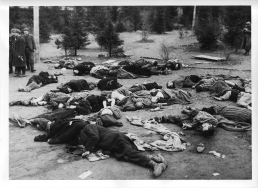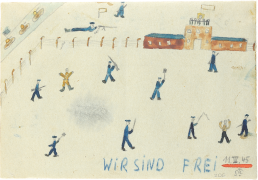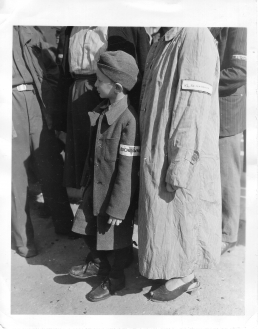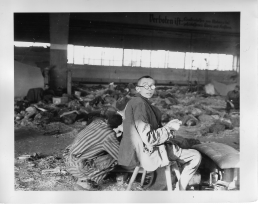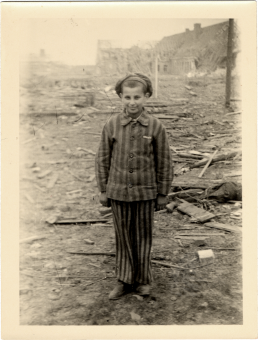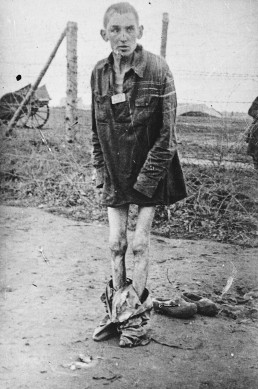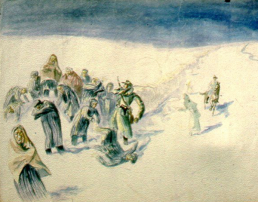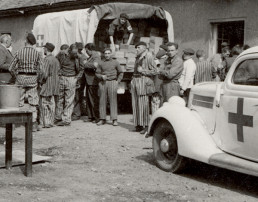Liberated in Buchenwald and Mittelbau Dora
In the fall of 1944, the SS began to clear the camps in the east. Tens of thousands of prisoners arrived at Buchenwald and Mittelbau-Dora on evacuation transports from Auschwitz and elsewhere. Among them were many children and adolescents.
In early April 1945, the US Army reached Thuringia. The SS began to clear out Buchenwald and Mittelbau-Dora. They sent almost 70,000 people on rail transports or forced marches to Dachau, Theresienstadt or Bergen-Belsen. Many did not survive.
On 11 April, American tanks reached the Ettersberg, forcing the SS to flee. Political prisoners took control of the camp. Buchenwald was thus liberated both from the outside and the inside. Among those liberated were nearly 900 children and young people.
In the southern Harz, the SS succeeded in completely clearing almost all of the Mittelbau concentration camps. Only in the Dora and Boelcke garrison camps were a few hundred sick and dying people left behind. They were liberated by the US Army on 11 April.
"What will happen then? Will we be evacuated? But where to? In the south they are approaching Halle.... To the north, another attacking force is approaching Hanover. Towards the east? Surely not far, because 300 kilometers from us is the Russian front. We are very afraid of the evacuation, because we know how those from Auschwitz and Groß-Rosen suffered during the transport."
Diary entry by Emile Delaunois, 1 April 1945.
The closer liberation came, the more uncertain the situation became for the prisoners. They feared death marches and massacres by the SS. Emile Delaunois (born Louis Lelong in 1910), was a clerk in the Woffleben subcamp of the Mittelbau-Dora Concentration Camp. He died shortly after liberation in the Bergen-Belsen Concentration Camp.
(Mittelbau-Dora Memorial)
Murdered prisoners in the north camp of the Ohrdruf subcamp, 6 April 1945.
In early April, the SS began to clear the Buchenwald subcamps . They sent the prisoners on transports back to the main camp. In several subcamps, such as Ohrdruf, they murdered those prisoners who were unable to march. US soldiers entered the camp on 6 April 1945.
(Buchenwald Memorial)
"The next day, the 10th of April, our complex was also to be evacuated. We hid wherever we could - in the hollow space between the boarding and cladding of the barrack wall, in the dark, musty and narrow space under the floor, under and in the stuffy straw sacks, or we squeezed ourselves into some stinking, vermin-infested sewage pit and refused to leave the block."
Account by Thomas Geve on his hiding place in Buchenwald's Little Camp, 1993.
The children and young people from Block 66 were also to be transported shortly before liberation. Many were able to hide and, like Thomas Geve (born Stefan Cohn in 1929), were liberated at Buchenwald on 11 April. Others were forced by the SS onto death marches, with a few escaping en route or being liberated by the Allies.
(Thomas Geve, Geraubte Kindheit, Constance 1993)
"Comrades, we have the camp in our hands!"
Account by Rolf Kralovitz of the liberation, 1995.
Rolf Kralovitz was 19 years old on the day of liberation and was in the main camp. In this interview he recalls how he perceived the liberation from “inside”.
(Buchenwald Memorial)
"When the door opened in the afternoon and two uniforms came in and these uniforms were different from the ones I was used to seeing for six years. But it is not only the uniforms, but the behavior of these two soldiers that made me understand that I was finally free. Tears of joy were then stuck in my throat."
Recollection by Leon Reich of his liberation in Buchenwald, 2015.
Unlike the prisoners in the main camp, the children and young people in Block 66 of the Little Camp saw little of what happened on the day of liberation. Leon Reich recalls this moment in an interview for the MDR film Die Kinder von Buchenwald (The Children of Buchenwald).
(MDR/Buchenwald Memorial)
Stefan Jakubowicz (now Stephen B. Jacobs) during a roll call after liberation, 1945.
On the day of liberation, Stefan Jacubowicz was five years old. He had been deported to Buchenwald with his father and brother in December 1944 and had survived thanks to the support of political prisoners in the Little Camp. In June 1945, he was brought to Switzerland with 300 other children as part of the Swiss relief operation. In 2002, he designed the memorial to the victims of the Little Camp at the Buchenwald Memorial.
(Buchenwald Memorial)
"There were still some able-bodied prisoners in the camp who had hidden in the infirmary before the camp was evacuated and now began to 'organize' something. They left the camp and brought back bread, milk, butter, bacon, potatoes, and even cigarettes they had found in a factory in Nordhausen."
Account by Roger de Coster, circa 1991.
The 16-year-old Belgian was one of about 80 prisoners liberated by US soldiers in the infirmary of the Dora camp on 11 April 1945.
(Mittelbau-Dora Memorial)
Liberations
Liberated on death marches
As Allied troops approached in early 1945, the SS began to clear the first subcamps of the Buchenwald Concentration Camp, evacuating the prisoners to the main camp or to other camps.
Life in the liberated camp
Many liberated prisoners were in a deplorable condition. Some were more dead than alive. Despite self-sacrificing help from US medics and civilian helpers, hundreds of people still died…
